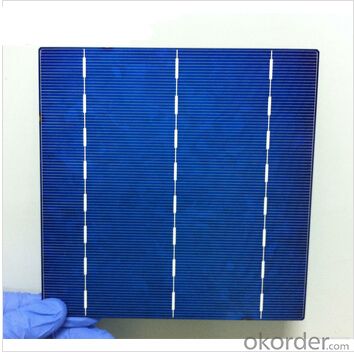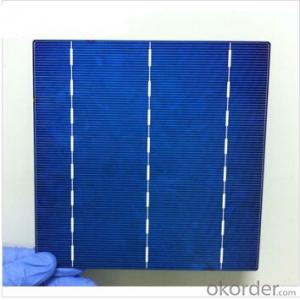Polycrystalline Solar Cells Series- 17%-18% 156mmx156mm±0.5mm
- Loading Port:
- Shanghai
- Payment Terms:
- TT OR LC
- Min Order Qty:
- 3000 pc
- Supply Capability:
- 1000000 pc/month
OKorder Service Pledge
OKorder Financial Service
You Might Also Like
Solar Cells:
Solar cells is made by solar wafer, it has three categories of solar cell right now, monocrystalline polycrystalline and thin film,These cells are entirely based around the concept PN junction, which is the critical part of solar module, it is the part that can convert the light energy into electricity, the thickness is from 180um to 200um, with even busbars to conduct electricity, textured cell can decrease diffuse reflection; they are often electrically connected and encapsulated as a module. Photovoltaic modules often have a sheet of glass on the front (sun up) side, allowing light to pass while protecting semiconductor wafers from abrasion and impact due to wind-driven debris, rain, hail, etc. Solar cells are also usually connected in series in modules, creating an additive voltage. Connecting cells in parallel will yield a higher current;With high quality and stable quality. Our Cells can greatly improve the performance of Solar Modules.
Polycrystalline silicon, or multicrystalline silicon (multi-Si) cells are made from cast square ingots—large blocks of molten silicon carefully cooled and solidified. They consist of small crystals giving the material its typical metal flake effect. Polysilicon cells are the most common type used in photovoltaics and are less expensive, yet less efficient than those made from monocrystalline silicon.
Features:
1. High conversion efficiencies resulting in superior power output performance.
2. Outstanding power output even in low light or high temperature conditions
3. Optimized design for ease of soldering and lamination
4. Long-term stability, reliability and performance
5. Low breakage rate
6. Color uniformity
Solar Cells Advantage:
1. Tire-1 Solar Cells’ Manufacturer Quality Guarantee. With a complete and sophisticated quality government system, our Quality Management have arrived world’s leading place. Customer can receive Tire-1 Cells Maker’s Quality Standard Products.
2. Trusted Warranty. We can supply trusted after-sales service to our customer. If our cells are found not in conformity to the specification of manufacturer, or should the inspected quantity found in shortage, or should the packing found damaged, the buyer has the right to claim to the seller. The claim, if any, should be presented to seller within 30 days after cargo's arrival date to the port, together with related inspection report and photos issued and provided by a reputable independent surveyor such as SGS.
3. World’s Leading Manufacturer Equipment. We imported the newest and leading production equipment from abroad. Advanced equipment can guarantee the stable quality of cells. Auto production line can also save labor cost which will further cut our production cost.
4. Bulk supply: With the production capacity of 500MW, we can produce large quantity every month. This can satisfy most customer requirement.
Specifications:
Dimension | 156mmx156mm±0.5mm |
Thickness(Si) | 180µm ±20µm, 200µm±20µm |
Front | Blue silicon nitride anti-reflective coatings 1.4mm silver busbar |
Back | Full-surface aluminum back-surface field 2.5mm(silver/aluminum discontinuous soldering pads) |
Efficiency code | 182 | 180 | 178 | 176 | 174 | 172 | 170 | |
Efficiency | Eff(%) | 18.20 | 18.00 | 17.80 | 17.60 | 17.40 | 17.20 | 17.00 |
Power | Ppm(W) | 4.43 | 4.38 | 4.33 | 4.28 | 4.23 | 4.19 | 4.14 |
Max. Power current | Ipm(A) | 8.26 | 8.22 | 8.17 | 8.12 | 8.08 | 8.05 | 7.99 |
Short Circut Current | Isc(A) | 8.71 | 8.68 | 8.63 | 8.60 | 8.56 | 8.53 | 8.49 |
Max. Power Voltage | Vpm(V) | 0.536 | 0.533 | 0.530 | 0.527 | 0.524 | 0.521 | 0.518 |
Open Cirtuit Voltage | Voc(V) | 0.634 | 0.632 | 0.630 | 0.627 | 0.625 | 0.622 | 0.620 |

FAQ
We have organized several common questions for our clients,may help you sincerely:
①What price for each watt?
It depends on the efficiency of the solar cell, quantity, delivery date and payment terms.
②How long can we receive the product after purchase?
In the purchase of product within three working days, We will arrange the factory delivery as soon as possible. The pecific time of receiving is related to the state and position of customers.Commonly 7 to 10 working days can be served.
③Can you provide the peripheral products of the solar panels, such as the battery, controller, and inverter? If so, can you tell me how do they match each other?
Yes, we can, we have two companies for solar region, one is CNBM International, the other is CNBM engineering Co.
We can provide you not only the solar module but also the off grid solar system, we can also provide you service with on grid plant.
④What is your warranty of solar cell?
Our product can promise lower than 0.3% open box crack, we support claim after opening the box if it has crackm color difference or sth, the buyer should give pictures immediately, we can not accept the claim after the solar cell has assembled to solar panel.
• Timeliness of delivery
• ⑤How do you pack your products?
We have rich experience on how to pack the solar cell to make sure the safety on shipment, we could use wooden box or pallet as buyer's preference.
- Q:Monocrystalline silicon and polycrystalline silicon cell in the appearance of what is the difference?
- From the appearance point of view: monocrystalline silicon cell four corners were arc-shaped, no surface pattern; polysilicon cell four corners for the square angle, the surface has a similar pattern of ice flowers.
- Q:Is the Photovoltaic cell panel good to save the energy?
- There is no doubt that the photovoltaic cell panel is very useful and efficient in saving the power in human's life, not only daily life but in other industries.
- Q:Can solar cells be used in public charging stations for electric vehicles?
- Yes, solar cells can be used in public charging stations for electric vehicles. By harnessing solar energy, these charging stations can provide clean and renewable power to charge electric vehicles, reducing reliance on traditional grid electricity and contributing to a more sustainable transportation system.
- Q:What is the impact of wind on solar cell performance?
- The impact of wind on solar cell performance can be both positive and negative. On one hand, a gentle breeze can help cool the solar panels, preventing them from overheating and increasing their efficiency. On the other hand, strong winds can cause mechanical stress on the panels and their mounting systems, potentially leading to damage or reduced performance. Additionally, excessive wind can cause dust and debris to accumulate on the panels, blocking sunlight and reducing their efficiency. Therefore, while some wind can have a beneficial impact, it is important to strike a balance to ensure optimal solar cell performance.
- Q:What is the cost of producing a solar cell?
- The cost of producing a solar cell can vary depending on various factors such as the type and size of the cell, manufacturing technology, materials used, and economies of scale. On average, the cost ranges from $0.15 to $0.40 per watt for the production of a standard crystalline silicon solar cell. However, with advancements in technology and increasing global demand, the cost has been steadily decreasing over the years.
- Q:Can solar cells be used for powering schools?
- Yes, solar cells can be used for powering schools. Solar panels can be installed on rooftops or in open spaces near the school to capture sunlight and convert it into electricity. This renewable energy source can help meet the energy needs of schools, reducing their reliance on fossil fuels and lowering their carbon footprint. Additionally, solar power can provide a reliable and cost-effective source of electricity for schools, allowing them to save on energy expenses in the long run.
- Q:How do solar cells perform in low-light conditions?
- Solar cells perform less efficiently in low-light conditions compared to bright sunlight. The amount of electricity generated by solar cells is directly proportional to the intensity of light they receive. Therefore, in low-light conditions, such as during cloudy days or in shaded areas, solar cells produce less electricity. However, advancements in technology have improved the performance of solar cells in low-light conditions, enabling them to still generate some power even under these circumstances.
- Q:Can solar cells be used in recreational vehicles or boats?
- Yes, solar cells can be used in recreational vehicles or boats. They provide a sustainable and reliable source of power, allowing for the generation of electricity without the need for external fuel sources. This makes solar cells an ideal solution for off-grid power needs in these applications, providing an eco-friendly and cost-effective alternative to traditional energy sources.
- Q:Can solar cells be used in residential communities?
- Yes, solar cells can be used in residential communities. In fact, they are increasingly being adopted by homeowners and communities as a sustainable and cost-effective energy source. Solar panels installed on rooftops or in shared spaces can generate electricity by converting sunlight into usable energy, helping to reduce reliance on traditional power grids and lowering electricity bills.
- Q:I would like to use a ppt to show how solar cells can work in a power generation factory, can anybody share some useful information with me?
- For a ppt, I think you should start with the definition of solar cells to give a basic introduction of solar cells.
1. Manufacturer Overview |
|
|---|---|
| Location | |
| Year Established | |
| Annual Output Value | |
| Main Markets | |
| Company Certifications | |
2. Manufacturer Certificates |
|
|---|---|
| a) Certification Name | |
| Range | |
| Reference | |
| Validity Period | |
3. Manufacturer Capability |
|
|---|---|
| a)Trade Capacity | |
| Nearest Port | |
| Export Percentage | |
| No.of Employees in Trade Department | |
| Language Spoken: | |
| b)Factory Information | |
| Factory Size: | |
| No. of Production Lines | |
| Contract Manufacturing | |
| Product Price Range | |
Send your message to us
Polycrystalline Solar Cells Series- 17%-18% 156mmx156mm±0.5mm
- Loading Port:
- Shanghai
- Payment Terms:
- TT OR LC
- Min Order Qty:
- 3000 pc
- Supply Capability:
- 1000000 pc/month
OKorder Service Pledge
OKorder Financial Service
Similar products
New products
Hot products
Related keywords

























